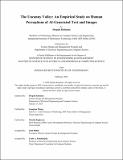The Uncanny Valley: An Empirical Study on Human Perceptions of AI-Generated Text and Images
Author(s)
Kishnani, Deepali
DownloadThesis PDF (4.940Mb)
Advisor
Zhang, Juanjuan
Terms of use
Metadata
Show full item recordAbstract
This thesis explores how the uncanny valley phenomenon—historically tied to near-human robots—applies to text-based AI interactions and AI-generated images. While the concept has been predominantly studied in the context of robotics, the advent of generative AI reveals that text and visuals that are 'almost, but not quite' human can also provoke unease.
Two experiments structure the study. The first examines GPT4-Turbo (GPT4o) text conversations. Sixty participants engaged with one of three “chatbots”: an “Uncanny-Valley Bot” (prompt engineered to fall in the uncanny valley), a “Human-Like Bot” (prompt engineered to converse like humans), or a human control. Godspeed Questionnaire results indicate that the uncanny valley effect surfaces in text-only form: participants consistently rated the “Uncanny-Valley Bot” lowest in anthropomorphism, animacy, likeability, and perceived intelligence. Furthermore, the experiment revealed that the distinction between GPT and humans is becoming increasingly blurred, with 60% of participants mistaking a human for GPT and 40% mistaking GPT for a human. Lastly, results highlighted a strong user preference for naturalness, human imperfections, and vulnerability. While human flaws enhance relatability, deviations that disrupt perceived humanity trigger the uncanny valley.
The second experiment investigates AI-generated images produced by Stable Diffusion XL at varying degrees of realism. Fifty-six participants ranked each image’s “strangeness,” revealing that highly realistic or clearly stylized outputs raise fewer concerns. By contrast, images that inhabit the uncanny valley elicited discomfort. To quantify these findings, recognized metrics like Frechet Inception Distance (FID) and Kernel Inception Distance (KID) were used to compare real and AI-generated images. Both metrics strongly correlated with human perceptions, suggesting that distance metrics can be used to determine realism. The study also shows that image generation models can detect visual features associated with the uncanny valley. However, performance drops when the prompt calls for subtle, “mid-range” realism, indicating the model’s difficulty in maintaining comfort and believability at intermediate levels.
Collectively, the two experiments confirm that uncanny valley responses are not confined to physical robots but persist in text-based dialogue and AI-synthesized images. Yet challenges remain. Short interaction windows, small participant samples, and reliance on selected AI models call for studies on the generalizability of these findings. Future work should adopt longitudinal designs, larger samples, and multiple AI systems. Addressing the uncanny valley in both textual and visual content is essential for advancing user trust, and comfort in AI.
Date issued
2025-02Department
Massachusetts Institute of Technology. Department of Electrical Engineering and Computer Science; System Design and Management Program.Publisher
Massachusetts Institute of Technology